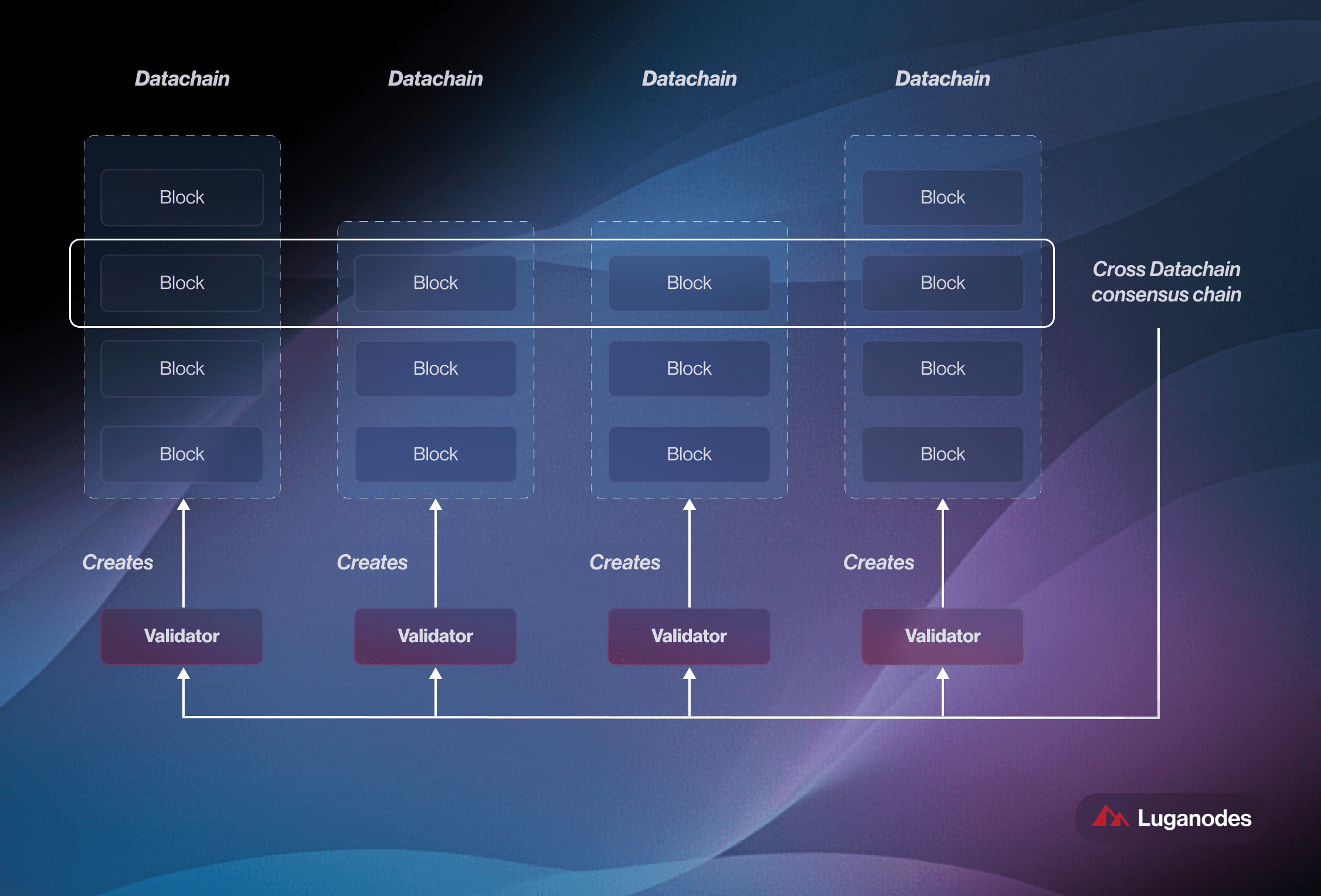7 min read
Somnia: On-Chain, In Real Time
Max TPS + EVM Compatible

Introduction
As on-chain gaming and real-time applications mature, performance has become the defining bottleneck. Most blockchains provide transaction speeds sufficient for DeFi, but far from what’s required for persistent, interactive virtual environments.
For example, Web3 gaming has amassed 1.5B + unique active wallets in the last year (DappRadar), yet most gameplay logic still occurs off-chain due to throughput and latency constraints.
Somnia, a new Layer-1 blockchain, aims to change that. Designed to handle over 1 million TPS with sub-second finality, Somnia is built for dynamic on-chain use cases such as gaming, metaverse environments, and real-time financial applications, all at transaction fees below one cent.
The Journey to Somnia
Co-founder Paul Thomas, a computer scientist turned metaverse developer, began exploring how to make user interaction and asset transfers occur fully on-chain. Decentralized blockchains offered a strong foundation for digital asset transfer, but enabling simultaneous interaction and transaction proved impossible, every chain tested eventually collapsed under heavy workloads.
This led the team to conclude that true performance required a ground-up rewrite, rather than layering solutions on top of existing architectures.
Why Build a Layer-1?
Somnia’s founders initially explored Layer-2 solutions but quickly realized their limits. Large-scale gaming and metaverse environments require millions of users interacting simultaneously on-chain, something existing L2 architectures struggle to support due to bandwidth and coordination overhead.
Somnia needed native high throughput and low latency, achievable only with a Layer-1 built from scratch. After testing off-the-shelf frameworks and existing clients, the team found none capable of sustaining real-time workloads at scale, leading to a full rewrite of the base architecture.
Somnia’s Architecture
Somnia reimagines base-layer performance from first principles. It targets 1M+ TPS, sub-second finality, and native EVM compatibility, without reliance on L2s or off-chain execution.
TPS — Transactions Per Second: how many actions the chain can process
Finality — When a transaction becomes irreversible
EVM — Ethereum Virtual Machine: execution environment for Solidity apps
Instead of scaling by adding layers, Somnia restructures consensus, data flow, and execution to operate at near hardware-limit throughput while retaining full Solidity tooling and simple migration.
Innovations that Power Somnia
Somnia’s architecture is defined by key innovations:
- MultiStream Consensus — parallel PoS block production with deterministic merge
- Independent Data Chains — per-validator data streams for continuous throughput
- Consensus Chain — separate PBFT-based finalization layer coordinating all data chains
- Compiled Bytecode — EVM compiled to native machine code for C++-class execution speed
- IceDB — nanosecond-latency deterministic state storage with snapshotting
- Streaming Compression + BLS Aggregation — bandwidth-efficient data propagation and signature batching
Together, these decouple data availability, execution, and consensus, enabling real-time synchronization and massive parallelism without sacrificing decentralization or developer experience.
MultiStream Consensus
At the core of Somnia’s performance lies MultiStream, a consensus design that reimagines how validators create and agree on blocks.
Instead of competing to extend a single global chain, each validator in Somnia runs its own data chain, an independent mini-blockchain recording its local transaction stream. Inspired by the 2024 paper Autobahn: Seamless High-Speed BFT, this approach removes bottlenecks inherent in traditional Proof-of-Stake systems.
How MultiStream Works
In a conventional PoS blockchain, all validators propose, vote, and finalize blocks on one global timeline. This forces sequential processing - only one block can be added at a time.
Validators append transactions to their own local data chains continuously.
Periodically, the network takes a synchronized snapshot: the consensus chain (running a modified PBFT PoS protocol) collects the current head of every validator’s data chain and finalizes them in a single consensus block.
Finalizing a head makes all transactions up to that head canonical and effectively irreversible under the protocol’s security assumptions.
If a validator submits invalid or conflicting data, the consensus mechanism detects it immediately and slashes the validator.

Why It Matters
This parallelism yields massive throughput while preserving determinism, given the same inputs, every node always produces the exact same state and transaction order.
Other chains parallelize specific layers:
- Solana parallelizes data propagation (Turbine)
- Aptos parallelizes execution (Block-STM)
- Somnia extends parallelization to block production itself.
The result: near-instant finality, high security, and throughput in the millions, without compromising EVM compatibility or developer experience.
Compiled Bytecode for High Throughput
Most blockchains try to speed up by running many transactions at once. That works when activity is spread out, but during big spikes (like a major mint or heavy trading on one asset), everyone hits the same state, and parallel execution breaks down.
Somnia takes a different path: instead of splitting work across many cores, it makes one core extremely fast by compiling EVM code into native x86 CPU instructions.
This strips away unnecessary steps (like redundant VM steps) and lets the processor use its built-in speed tricks (like out-of-order execution) to run things much faster. Only the most-used contracts are compiled; the rest run normally.
IceDB
Most blockchains use embedded databases like LevelDB (Google) or RocksDB (Meta) to store state data. These are fast but not designed for deterministic execution, i.e. read/write performance varies depending on memory conditions.
Somnia’s IceDB solves this with:
- Deterministic read/write performance
- Smart in-memory caching for hot data
- Native snapshotting
- 15–100 nanosecond access speeds
This ensures predictable gas costs, identical execution across nodes, and real-time performance.
Advanced Compression Techniques
At ultra-high throughput, moving transaction data between validators becomes the bottleneck. Without advanced compression, chains must either cap throughput or centralize. Somnia avoids this via real-time streaming compression.
Techniques
- Power-law compression — compresses “hot” addresses into a few bits
- Streaming compression — references prior stream data instead of compressing block-by-block
- BLS signature aggregation — combines thousands of signatures into one
- Bandwidth symmetry — each validator streams its own shard, avoiding leader overload and enabling near hardware-limit throughput
Somnia for Gaming
Gaming is the natural first market. The team engages Web2 developers by focusing on new business models, asset composability, and verifiable digital ownership.
Somnia’s low fees and high throughput make it especially valuable for smaller Web3 studios that subsidize gas or struggle to scale without costly L2s or custom chains. Fully on-chain logic enables richer mechanics, asset reuse, and mod-driven innovation, just as major gaming genres emerged from mods.
While AAA studios remain cautious, independent creators exploring new economic and design frontiers are increasingly receptive. Somnia supports them with infrastructure, funding, and distribution.
Beyond Gaming
Although gaming is the clear starting point, Somnia's architecture enables broader real-time on-chain economies:
- Real-time finance - order books, HFT-style systems
- Metaverse & social - persistent virtual worlds, decentralized social graphs
- AI environments - agent simulation, on-chain inference routing
- Creator economies - user-generated logic and mod economies
- Supply chain & IoT - sensor streams and machine commerce
These workloads historically lived off-chain or on centralized infrastructure. Somnia aims to bring them on-chain making them trustless and programmable.
Conclusion
Somnia’s origins reflect its ethos of solving problems for builders. By designing for metaverse-scale environments, the team created an architecture now attracting forward-thinking developers.
Somnia demonstrates what a modern high-performance L1 can look like when optimized for interaction, not just settlement. The technology is foundational, but adoption will ultimately come from great games and new user experiences.
About Luganodes
Luganodes is a world-class, Swiss-operated, non-custodial blockchain infrastructure provider that has rapidly gained recognition in the industry for offering institutional-grade services. It was born out of the Lugano Plan B Program, an initiative driven by Tether and the City of Lugano. Luganodes maintains an exceptional 99.9% uptime with round-the-clock monitoring by SRE experts. With support for 45+ PoS networks, it ranks among the top validators on Polygon, Polkadot, Sui, and Tron. Luganodes prioritizes security and compliance, holding the distinction of being one of the first staking providers to adhere to all SOC 2 Type II, GDPR, and ISO 27001 standards as well as offering Chainproof insurance to institutional clients.
The information herein is for general informational purposes only and does not constitute legal, business, tax, professional, financial, or investment advice. No warranties are made regarding its accuracy, correctness, completeness, or reliability. Luganodes and its affiliates disclaim all liability for any losses or damages arising from reliance on this information. Luganodes is not obligated to update or amend any content. Use of this at your own risk. For any advice, please consult a qualified professional.